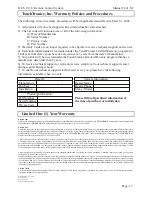
On/Off Toggle Switch
Select a place on the dash or console that is easily accessible and easily visible so that the status
indicator light on the switch may be seen.
Factory Door Lock
Vehicle door lock circuits are factory designed as positive pulse, negative pulse or reversal rest
@ ground circuits. Determine which type of door lock circuit is used in your vehicle.
Positive Pulse System:
The switch has 3 wires. The input terminal, usually the center terminal, is
+12v. When the switch knob is pressed (momentarily On) one of the other terminals is also +12v.
This means that the switch is sending a +12v (positive pulse) signal to lock or unlock the door. There
is a special relay in this circuit which handles the ‘reversal rest @ ground’ circuit required for most
motor operations. Most GM vehicles use a Positive Pulse circuit for door locks. Check the number
of wires on the switch and check the input wire to the switch. It should be a +12v signal. See
diagram pg 11.
Negative Pulse System:
The switch has 3 wires. The input terminal, usually the center terminal, is
ground. When the switch knob is pressed (momentarily On) one of the other terminals is also
ground. This means that the switch is sending a ground (negative pulse) signal to lock or unlock the
door. There is a special relay in this circuit which handles the ‘reversal rest @ ground’ circuit
required for most motor operations. Most foreign cars use a Negative Pulse circuit for the door
locks. Check the number of wires on the switch and check the input wire to the switch. It should be a
ground signal. See diagram pg 11.
Reversal Rest @ Ground System:
This switch usually has 5 wires (sometimes 4 wires). All of the
wires and terminals rest @ ‘ground’ when the switch is not activated. One terminal b12v
(positive) only when the switch is activated. The switch sends a positive signal through the system
and turns on the motor. The ground signal from the motor passes through the other side of the switch
and goes to a chassis ground. There is no special relay in this circuit because the switches are hard-
wired to handle the high current of the ‘reversal rest @ ground’ circuit required for most motor
operations. Most Ford vehicles and most Chrysler vehicles use a Reversal Rest @ Ground circuit for
door locks. Check the number of wires on the switch. If there are 4 or 5 wires, then the circuit is
probably a reversal rest @ ground circuit. See diagram pg 11.
To determine which type is used in your vehicle, take a voltmeter and probe one of the output wires at
the switch. Check the polarity with the switch pressed and without the switch pressed. Compare
results with the chart below.
**Please Note: The following diagrams / schematics are for reference only. The installer must
verify that the circuit is properly wired with the correct gauge of wire, and properly fused the
correct fuse size and type for the circuit.
Page -7-
Installation: Planning, Continued
Door Lock Switch
Positive Pulse
Negative Pulse
Reversal Rest@Ground
Switch NOT Pressed
No Voltage / Floats
No Voltage / Floats
Ground
Switch Pressed
+12 Volts
Ground
+12 Volts
Typical # of Wires
3 Wires
3 Wires
5 Wires
Output Terminals
3 of Terminals
R.E.S.C.U.E. Remote Control System
Manual C841.N2




































